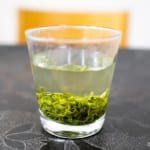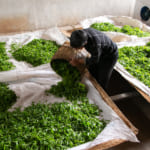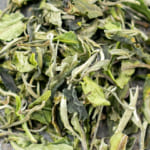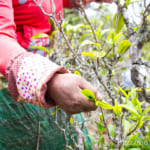- HOME >
- Tea constituents and functional effect
The Real Cause of Astringency in Tea

It’s a common misconception that tannin is solely responsible for the astringency in tea. There are actually two main root causes of astringency in tea, tannins being one of them, while the other is minerals. So, besides tannins, minerals also play a significant role in creating the astringency in tea.
Difference between tannin and poly phenol
Summer or autumn tea is known to be astringent, and drinking these teas on an empty stomach can cause discomfort and even nausea. Some people believe that astringency is a characteristic of black tea, and therefore, they avoid it due to their weak stomach. However, the astringency in black tea has nothing to do with its type. Most commercial black teas are made from summer-harvested tea, which contains a distinctive polyphenol called EGCG. This particular polyphenol conjugates with the protein in our body, causing astringency or discomfort. Substances that have the property to conjugate with protein belong to the tannin group. It’s important to note that the term tannin doesn’t refer to a specific substance, but rather a group of substances that produce tannin-like reactions.
On the other hand, spring black tea contains less EGCG, and thus, it doesn’t cause any uncomfortable sensations in our mouth or stomach.
Minerals can cause dryness on our tongue
There’s another type of astringency that can occur in tea, which happens when we drink oxidized tea. This type of astringency doesn’t cause stomach problems, but it can create an irritating sensation and an immediate dry, chalky feeling in the mouth. This type of astringency isn’t caused by tannins; instead, it’s caused by specific types of minerals. In addition to oxidized tea, this type of astringency can also be caused by tea that has been fried at very high temperatures or grown with a lot of fertilizer.
Magnesium Causes Astringency
A familiar example to understand how minerals can cause astringency is canned drinks, such as canned beer packed in aluminum. If you compare the same type of drink in a can, glass, or PET bottle, you’ll notice that the canned drink creates a dryness on the tongue. This can easily be sensed by comparing Coca-Cola from a can and a PET bottle.
There are several minerals, such as copper, magnesium, silver, aluminum, and zinc, that can cause astringency. I’ve studied the effect of each mineral on the taste of water and tea, and I’ve noticed that the astringency caused by magnesium produces the same sensation as oxidized tea. When I add magnesium to green tea, it creates the same type of astringency as oxidized green tea. Based on this finding, I believe that magnesium is primarily responsible for the mineral-induced astringency in tea.
Chlorophyll in Tea Contains Magnesium
Tea contains a significant amount of magnesium, which is located in the centre of the molecule of chlorophyll, the green pigment in tea.
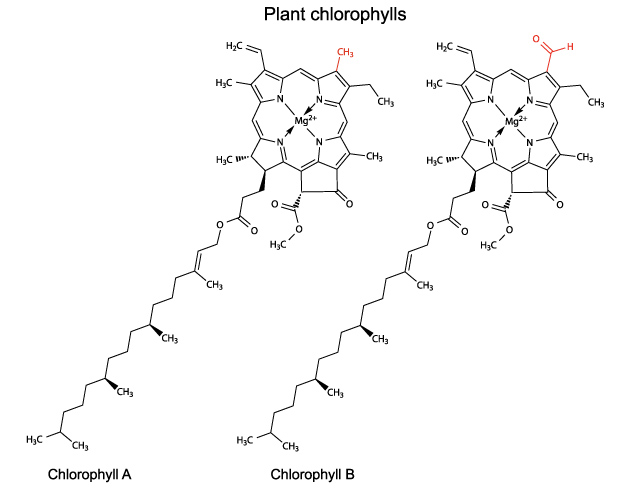
The magnesium atom is located in the center of the molecule shown above.
Chlorophyll is a highly unstable substance that is easily oxidized. When oxidation occurs, chlorophyll is converted into a substance called Pheophytin, and magnesium is released. We do not typically taste magnesium when it is bonded with organic substances like chlorophyll, but once the magnesium is released, it can greatly affect the taste of the tea. In particular, magnesium contributes to the astringency and bitterness of the tea.

Gyokuro Tea Garden
I believe that the reason why the oxidized green tea gives strong astringency is due to the oxidation of chlorophyll. Similarly, the tea pan-fried at higher temperature also becomes astringent. High temperature during frying damages/oxidize chlorophyll and magnesium is released from chlorophyll.
Gyokuro and Matcha contains more chlorophylls than ordinary tea. It is because of these teas are produced under the shade and tealeaf needs more chlorophylls in order to effectively capture the sunshine. Therefore, the oxidized matcha or gyokuro gives much more astringency and bitterness than other teas.
The reason why black tea and oolong is not astringent
Black tea or oolong does not remain the chlorophyll. In these teas, chlorophylls are mostly oxidized and broken. However, black tea or oolong tea is not astringent unless these teas get oxidized. The magnesium in those teas may be forming a complex with other substance being formed during the enzymatic oxidation of poly phenol. Since magnesium does not exist in a free form, it does not contribute to astringent taste.
The reason why the fertilized tea is astringent
One of the reasons why fertilized tea is astringent is related to the amount of chlorophyll. If fertilizer is used, tea trees will grow faster and bigger. Consequently, it synthesizes more chlorophylls and conducts more photo-synthesis. Obviously, the fertilized vegetable or tea are so much greener due to higher content of chlorophyll.
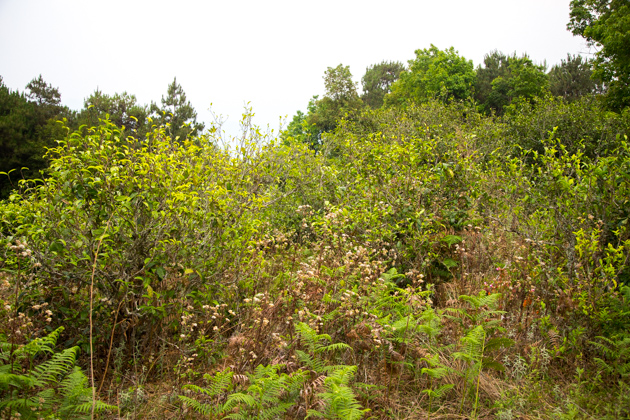
Sustainable Tea Garden kept without fertilizer
On the contrary, the tea leaf of sustainable tea garden is yellow in colour. Because of no fertilizer is used, tea trees grow very slowly and thus it contain less chlorophyll. Tea tree require less photo-synthesis. It could be the reason why sustainable tea gives a clean taste with very less astringency.
Related Articles
How to get the latest update on HOJO?
1. Follow Twitter, 2. Click "Like" on Facebook, and 3. Subscribe in newsletter. You can have the latest tea news from HOJO.
 Subscribe the Newsletter to enjoy the privileges
Subscribe the Newsletter to enjoy the privileges- You may receive a free sample upon purchase, or you may have the priority to purchase special products. So please remember to subscribe our newsletter as well as the social network.
- Bi Luo Chun: Exquisite Green Tea from East Dongting Shan
- Bi Luo Chun is one of China’s most famous green teas, renowned for its superior quality and unique flavo …
- New Release of Wild Pu-erh Jasmine Pearl
- Out of curiosity, we decided to create a jasmine tea based on Da Xue Shan Wild Raw Tea. This resulted in an ex …
NEW ARTICLES
 Bi Luo Chun: Exquisite Green Tea from East Dongting Shan
Bi Luo Chun: Exquisite Green Tea from East Dongting Shan- Bi Luo Chun is one of China’s most famous green teas, renowned for its superior quality and unique flavo …
 Unexpected Tea Growth in the 2024 Yunnan Tea Season
Unexpected Tea Growth in the 2024 Yunnan Tea Season- After completing an extensive procurement trip in Yunnan Province, I am currently staying in Kuala Lumpur, Mal …
 Three Completely Different Ways to Enjoy White Tea
Three Completely Different Ways to Enjoy White Tea- White tea has been gaining popularity and attention recently, prompting exploration into various ways to enjoy …
 New Release of Wild Pu-erh Jasmine Pearl
New Release of Wild Pu-erh Jasmine Pearl- Out of curiosity, we decided to create a jasmine tea based on Da Xue Shan Wild Raw Tea. This resulted in an ex …
 2024 Overview: Our Yunnan White Tea Quality, Process, and Weather Insights
2024 Overview: Our Yunnan White Tea Quality, Process, and Weather Insights- One of the teas we’ve been focusing on in Yunnan Province is white tea. Historically white tea has been …
 Yunnan’s Hospitality Culture: Expressed Through Meals
Yunnan’s Hospitality Culture: Expressed Through Meals- In China, as a form of greeting, it’s common to say “你吃饭了吗?” which means “Have you eat …
 In Search of Wild Tea: Exploring Mountain Villages in Southwest Lincang, Yunnan
In Search of Wild Tea: Exploring Mountain Villages in Southwest Lincang, Yunnan- We are currently sourcing tea in the southwestern part of Lincang City, Yunnan Province. One of the crucial pr …
 New Release of Anxi Traditional Oolong
New Release of Anxi Traditional Oolong- Anxi, located in Fujian province, China, is celebrated for its Tie Guan Yin tea. However, the Traditional Anxi …
 Yunnan 2024 Spring Tea Sourcing
Yunnan 2024 Spring Tea Sourcing- Yunnan Province is globally renowned for the exceptional quality of its tea leaves. However, lax production ma …
 The Relationship Between Greenness of Tea Leaves and Fertilizer
The Relationship Between Greenness of Tea Leaves and Fertilizer- For both tea and vegetables, there’s a common misconception that a deeper green colour indicates better …
Category
- New Arrival at HOJO Online Shop
- Featured Articles
- Newsletter
- Types of Tea
- Origin of Tea
- Teapot and Tea Equipment
- Tea Column
- How to enjoy tea
- Tea Processing
- How to choose quality tea
- Tea constituents and functional effect
- Safety of Tea
- Foods
- Tea Business Operation
- Hobby and Outdoor Activity
- Ranking of Tea
- Video
- FAQ
- Media Release
Profile

- AKIRA HOJO
- I invite you to experience my tea selections.I was born in Nagano, Japan. In university, I studied agricultural chemistry, and I have the master degree in food science. I worked in Japanese food industry for 10 years. I involved in R&D, QC and QA. As a factory manager, I implemented ISO9000 series and managed the factory.
- The Art of Tea Magazine
- We posted the article on “The Art of Tea Magazine No.9, the magazine is published in Taiwan. We featured …
- New Straits Times
- The Malaysian National Newspaper, New Straits Times featured HOJO Tea on 17-Oct-2007.
Shop Info

Address:Lot No. T-215, 3rd Floor, The Gardens Mall, Mid Valley City, Lingkaran Syed Putra, 59200 Kuala Lumpur
Tel: +603-2287-4537
Business Hour: 10am to 10pm



